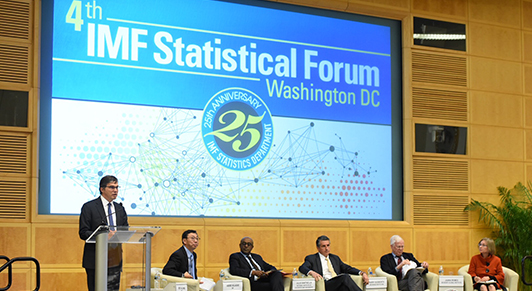
4th Statistical Forum
Statistical Forum on Inclusive Growth–Leaving Nothing Out and Nobody Behind
December 2, 2016
- Statistics can contribute to policies aimed at achieving inclusive growth
- Need to supplement, improve, and combine existing statistics with new and more granular data
- National and international organizations should play a more active role in developing the necessary data and coordinating the efforts across countries
Related Links
What is inclusive growth?
Inclusive growth has many dimensions. The income and wealth distribution within economies — segmented data by gender, social groups, and geographical area, and statistics that capture developments in a more globalized and digitized world economy — are some of the many dimensions that were discussed at the Forum. To guide the compilation of statistics and come up with informative indicators, a clear definition of inclusive growth is needed first.
Ravi Kanbur, Professor of Economics at Cornell University, and keynote speaker at the Forum, stressed that statistics may seem technical, but undoubtedly contain a political component, as shown by examples of colonial India. The framing of survey questions in India and the construction of the global poverty line showcased how simple decisions can have major implications for the policy debate. Such implications remain important as methodology is key in defining the Sustainable Development Goals (SDGs) indicators, of which many are related to inclusive growth.
Going beyond GDP
The increased attention to distributional and environmental issues, the role of the informal economy, and rapid technological developments, all put pressure on the use of GDP-based measures of output as a tool for monitoring economy activity. Participants discussed alternative metrics, including a mix of education, health, and living standard factors, that could supplement GDP to better capture welfare dynamics and enhance policy responses that make growth more inclusive.
Besides considering new compilation programs for supplementary statistics, there is room to enhance metrics that already fall within the GDP framework. For example, the emergence of new forms of intermediation services, such as AirBnB and Uber, and other benefits to consumers brought by Internet-based services have widened the perceived gap between output as measured by GDP, productivity, and welfare. Better measuring volumes and prices of digital services could improve the alignment of these concepts.
Combining statistics
A more globalized economy brings other measurement challenges, such as identifying the impact of offshoring. To enrich the analysis and better measure the impact of offshoring, additional statistics on prices, the labor force, and bilateral trade could be integrated in these approaches.
Using statistics from different sources also led to a better understanding of the progress made on financial inclusion. Data from the IMF’s Financial Access Survey show an increase of access to financial services over the past years, albeit unevenly around the world. Complementary data based on surveys of individuals and firms provide useful information on which segments of the population still lack access and what barriers they face.
The way forward
Led by IMF Deputy Managing Director Tao Zhang, the Forum concluded with a roundtable discussion on the inclusiveness of existing statistics and proposed way forward. The participants agreed that inclusiveness is difficult to capture in one metric given its many dimensions, and recommended a structured framework with a limited set of clearly defined indicators. Here, international organizations could play an important role by establishing and promoting data standards.
Micro-level data, Big Data, technological innovation, and administrative data could help deal with the massive compilation challenges that the proposed SDGs indicators bring forth. With so much new data becoming available, participants concurred that it is important not to lose focus of traditional statistics.







